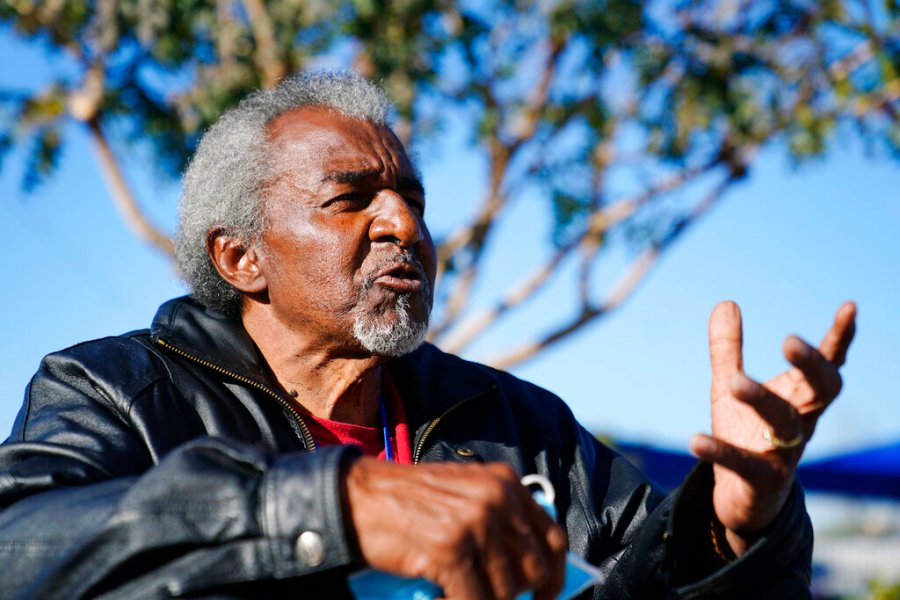PHOENIX (AP) — Karla Finocchio’s slide into homelessness began when she split with her partner of 18 years and temporarily moved in with a cousin.
The 55-year-old planned to use her $800-a-month disability check to get an apartment after back surgery. But she soon was sleeping in her old pickup protected by her German Shepherd mix Scrappy, unable to afford housing in Phoenix, where median monthly rents soared 33% during the coronavirus pandemic to over $1,220 for a one-bedroom, according to ApartmentList.com.
Finocchio is one face of America’s graying homeless population, a rapidly expanding group of destitute and desperate people 50 and older suddenly without a permanent home after a job loss, divorce, family death or health crisis during a pandemic.
“We’re seeing a huge boom in senior homelessness,” said Kendra Hendry, a caseworker at Arizona’s largest shelter, where older people make up about 30% of those staying there. “These are not necessarily people who have mental illness or substance abuse problems. They are people being pushed into the streets by rising rents.”
Academics project their numbers will nearly triple over the next decade, challenging policy makers from Los Angeles to New York to imagine new ideas for sheltering the last of the baby boomers as they get older, sicker and less able to pay spiraling rents. Advocates say much more housing is needed, especially for extremely low-income people.
Navigating sidewalks in wheelchairs and walkers, the aging homeless have medical ages greater than their years, with mobility, cognitive and chronic problems like diabetes. Many contracted COVID-19 or couldn’t work because of pandemic restrictions.
Cardelia Corley, 65, ended up on the streets of Los Angeles County after the hours at her telemarketing job were cut.
“I’d always worked, been successful, put my kid through college,” the single mother said. “And then all of a sudden things went downhill.”
Corley traveled all night aboard buses and rode commuter trains to catch a cat nap.
“And then I would go to Union Station downtown and wash up in the bathroom,” said Corley. She recently moved into a small East Hollywood apartment with help from The People Concern, a Los Angeles nonprofit.
A 2019 study of aging homeless people led by the University of Pennsylvania drew on 30 years of census data to project the U.S. population of people 65 and older experiencing homelessness will nearly triple from 40,000 to 106,000 by 2030, resulting in a public health crisis as their age-related medical problems multiply.
Dr. Margot Kushel, a physician who directs the Center for Vulnerable Populations at the University of California, San Francisco, said her research in Oakland on how homelessness affects health has shown nearly half of the tens of thousands of older homeless people in the U.S. are on the streets for the first time.
“We are seeing that retirement is no longer the golden dream,” said Kushel. “A lot of the working poor are destined to retire onto the streets.”
That’s especially true of younger baby boomers, now in their late 50s to late 60s, who don’t have pensions or 401(k) accounts. About half of both women and men ages 55 to 66 have no retirement savings, according to the census.
Born between 1946 and 1964, baby boomers now number over 70 million, the census shows. With the oldest boomers in their mid 70s, all will hit age 65 by 2030.
The aged homeless also tend to have smaller Social Security checks after years working off the books.
Donald Whitehead Jr., executive director of the Washington-based advocacy group National Coalition for the Homeless, said Black, Latino and Indigenous people who came of age in the 1980s amid recession and high unemployment rates are disproportionately represented among the homeless.

Many nearing retirement never got well-paying jobs and didn’t buy homes because of discriminatory real estate practices.
“So many of us didn’t put money into retirement programs, thinking that Social Security was going to take care of us,” said Rudy Soliz, 63, operations director for Justa Center, which offers meals, showers, a mail drop and other services to the aged homeless in Phoenix.
The average monthly Social Security retirement payment as of December was $1,658. Many older homeless people have much smaller checks because they worked fewer years or earned less than others.
People 65 and over with limited resources and who didn’t work enough to earn retirement benefits may be eligible for Supplemental Security Income of $841 a month.
Nestor Castro, 67, was luckier than many who lose permanent homes.
Castro was in his late 50s living in New York when his mother died and he was hospitalized with bleeding ulcers, losing their apartment. He initially stayed with his sister in Boston, then for more than three years at a YMCA in Cambridge, Massachusetts.

Just before last Christmas, Castro got a permanent subsidized apartment through Hearth Inc., a Boston nonprofit dedicated to ending homelessness among older adults. Residents pay 30% of their income to stay in one if Hearth’s 228 units.
Castro pays with part of his Social Security check and a part-time job. He also volunteers at a food pantry and a nonprofit that assists people with housing.
“Housing is a big problem around here because they are building luxury apartments that no one can afford,” he said. “A place down the street is $3,068 a month for a studio.”
Janie Har in Marin County, California, and Christopher Weber in Los Angeles contributed to this report.





